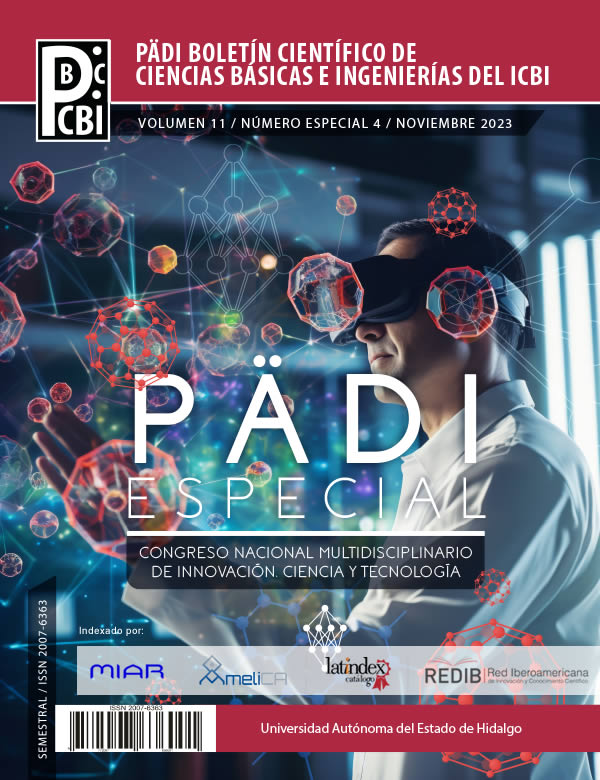Underactuated device for teaching-learning of control theory
Abstract
Control Theory is an interdisciplinary field of engineering and mathematical physical sciences that seems to be incomprehensible at first, perhaps due to the large amount of abstract knowledge required. However, this seems to improve by relating and applying the acquired concepts on experimental platforms. Thus, by highlighting the practical classes over the speculative ones, the creative capacity of the students is fostered (Klimenko and Botero Castello, 2016). Unfortunately, in most of the laboratories of the higher schools of the country (Mexico) there is not the adequate equipment to be able to implement said theory. For this reason, this manuscript presents the design and construction of an underactuated experimental platform of cost and maintenance low, it is known as cart-pendulum system, for the teaching-learning of control theory.
Downloads
References
Aliste, M. E. R., Real, D. L., and Bravo, I. L. (2006). ¿eres visual, auditivo o kinestésico? estilos de aprendizaje desde el modelo de la programación neurolingüística (pnl). Revista Iberoamericana de Educación, 38(2):1–10.
Bernal, M., Estrada, V., and Marquez, R. (2019). ´ Diseño e implementación de sistemas de control basados en estructuras convexas y desigualdades matriciales lineales, volume 1. Pearson: Mexico City, Mexico.
Blanco, L. J. (2012). Influencias del dominio afectivo en la enseñanza y el aprendizaje de las matemáticas. Teoría, crítica y práctica de la educación matemática, 41:171.
Blitzer, L. (1965). Inverted pendulum. American Journal of Physics, 33(12):1076–1078.
Bogdanoff, J. and Citron, S. (1965). Experiments with an inverted pendulum subject to random parametric excitation. The Journal of the Acoustical Society of America, 38(3):447–452.
Castro, A. (2012). Modeling and dynamic analysis of a two-wheeled inverted-pendulum. PhD thesis, Georgia Institute of Technology.
Cazau, P. (2004). Estilos de aprendizaje: Generalidades. Consultado el, 11(11):2005.
Cervantes L ́opez, M. J., Llanes Castillo, A., Peña Maldonado, A. A., and Cruz Casados, J. (2020). Estrategias para potenciar el aprendizaje y el rendimiento académico en estudiantes universitarios. Revista Venezolana de Gerencia, 25(90):579–594.
Chen, C.-T. (1984). Linear system theory and design. Saunders college publishing.
Cornejo Romero, C. (2023). Control en tiempo real de un sistema carro-péndulo. Universidad Nacional Autónoma de México.
Grossman, S., Stanley, I., et al. (2019). ́Algebra lineal. Biblioteca Hernán Malo González.
Halvorsen, H. P. (2011). Control and simulation in labview. Department of Electrical Engineering, Information Technology and Cybernetics, Telemark University College Porsgrunn, Norway.
Hernández Largacha, A., Legaspi Martínez, M., and Peláez Martín, J. (2012). Control inteligente del péndulo invertido. Universidad Complutense de Madrid.
Huerta Gil, R. D. (2015). Control de un péndulo invertido sobre dos ruedas de tres grados de libertad. Universidad Nacional Autónoma de México.
Infante, R. C. H., Miranda, M. E. I., Collaguazo, W. A., and Espinosa, J. S. P. (2021). Sugerencias metodológicas para el desarrollo de clases teóricas y prácticas en la enseñanza superior. Revista Conrado, 17(S1):16–23.
Klimenko, O. and Botero Castello, A. M. (2016). Fomento de la capacidad creativa desde las prácticas de enseñanza en una institución universitaria. Katharsis: Revista de Ciencias Sociales.
Lowenstern, E. (1932). Xxxix. the stabilizing effect of imposed oscillations of high frequency on a dynamical system. The London, Edinburgh, and Dublin Philosophical Magazine and Journal of Science, 13(84):458–486.
Mazzone, V. (2002). Estructuras prácticas de control siso. Automatización y Control Industrial, Universidad Nacional de Quilmes, page 3.
Murillo Herrera, S. et al. (2019). Robot caminador bipedo semi-pasivo como plataforma educativa de bajo costo. Universidad de los Andes.
Ness, D. J. (1967). Small oscillations of a stabilized, inverted pendulum. American Journal of Physics, 35(10):964–967.
Phelps III, F. and Hunter Jr, J. (1965). An analytical solution of the inverted pendulum. American Journal of Physics, 33(4):285–295.
Pippard, A. (1987). The inverted pendulum. European Journal of Physics, 8(3):203.
Ponce, I. (2022). Estabilización del carro péndulo invertido aplicando control óptimo no lineal variante en tiempo. Instituto de Ingeniería y Tecnología.
Quanser (2023). https://www.quanser.com/products/linear-servo-base-unit-inverted-pendulum/, 22 de Agosto de 2013
Ruvalcaba, F., Llama, M., and Santib ́anez, V. (2010). Control de un carro péndulo como un sistema de cuarto orden. In Congreso Anual.
Sahba, M. (1983). Computer-aided design of feedback controllers for nonlinear systems with applications to control of a double-inverted pendulum. In IEE Proceedings D-Control Theory and Applications, volume 6, pages 350–358.
Stephenson, A. (1908). On a new type of dynamical stability. Memoirs and Proceedings of the Manchester Literary and Philosophical Society, 52(8).
Yamakawa, T. (1989). Stabilization of an inverted pendulum by a high-speed fuzzy logic controller hardware system. Fuzzy sets and Systems, 32(2):161–180.
Copyright (c) 2023 Isaac Fernando Manriquez Silva, David Escalera Sierra, Kristian Freyri Maya Gress, Raúl Villafuerte Segura

This work is licensed under a Creative Commons Attribution-NonCommercial-NoDerivatives 4.0 International License.













